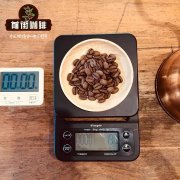What do Honduran coffee beans make by hand? coffee beans have alcoholic flavor Shirley coffee lychee orchid coffee flavor

Professional coffee knowledge exchange more coffee bean information please follow the coffee workshop (Wechat official account cafe_style)
When it comes to coffee in America, most of you will think of places like Brazil and Colombia. Today, Qianjie Coffee would like to introduce to you Honduras, a coffee producing country that also comes from America.
Honduras, a country located in Central America, is particularly unpopular among many Central American coffee-producing countries because it has not established diplomatic relations with China. But you may not know that since 2011, Honduras has surpassed Guatemala in coffee production to become the largest coffee producer in Central America and one of the top 10 coffee producers in the world!
On the development of coffee in Honduras
In fact, Honduran coffee is not so smooth at the beginning, compared with other Central American countries: Costa Rica, Guatemala, Nicaragua and so on, coffee development can be said to be very late.
The main reason for this is that the coffee industry in Honduras has been delayed by the lack of transportation to connect the origin to the port, but after 1970, the government created an official agency for coffee: Instituto Hondure?o del Cafe (IHCAFE), which is dedicated to improving coffee quality, and coffee trees can be planted all over Honduras, making Honduras's coffee production surpass that of Costa Rica and Guatemala in 2011!
However, Honduras is also facing the problems of leaf rust and global warming, which is a major issue in Honduras.
Flavor of Honduran coffee producing area
Honduras has six major coffee producing areas, mainly located in the western and southern regions of Copan, Opalaca, Montecillos, Comayagua, Agalta Tropical and El Paraiso, of which three are the main producing areas:
Montesius (Montecillos): the highest altitude producing area in Honduras, the coffee is bright and rich in texture, full of rich fruit and sweet aromas with citrus aromas.
Copan: the coffee beans of Koban are all chocolate flavor, mellow taste and high sweetness.
Agalta Tropical: the coffee beans in this area have a balance of honey sweetness and acidity, with chocolate tonality.
Generally speaking, the coffee alcohol and sweetness of Honduras are quite high, all fruit tone, but sometimes with nutty, taffy flavor, is quite multi-layered coffee.
The history of coffee beans in Honduras
Hongguo began to grow coffee at the end of the 19th century. Some countries have planted a lot at home after being introduced from other countries.
In contrast, Honduras has a large domestic crop, 90% of which is consumed at home. Probably feel that such good planting conditions, do not export is too bad, slowly start the export business. In 1990, exports were about tens of thousands of tons, and by 2018 it has reached about 360000 tons. Although the country is small, the production of coffee has reached the forefront of the world.
So how should Honduran coffee be made to taste good? The front street coffee tells you how to make Honduran coffee by hand.
Qianjie Coffee suggests brewing Honduran wine-flavored coffee beans:
1. Filter cup: v60
2. Water temperature: 90 ℃
3. Degree of grinding: moderate grinding
4. Ratio of powder to water: 1:15
5. Extraction time: about one minute and fifty seconds
Qianjie Coffee Analysis: because most Honduran coffee is deeply roasted and its flavor tends to chocolate, nuts and caramel, Qianjie coffee is recommended to brew with semi-immersed coffee filter cups such as KONO filter cup and kalita three-hole trapezoidal filter cup, while choosing a lower water temperature with a thicker grind to reduce the chance of coffee over-extraction. On the other hand, a small proportion of powder and water can increase the taste of the coffee and avoid the situation that it is easy to overextract when it is extracted to the later stage.
END
Important Notice :
前街咖啡 FrontStreet Coffee has moved to new addredd:
FrontStreet Coffee Address: 315,Donghua East Road,GuangZhou
Tel:020 38364473
- Prev

Test2
Test2
- Next

Where does the best quality coffee come from and what does it have?
Professional coffee knowledge exchange More coffee bean information Please pay attention to coffee workshop (Weixin Official Accounts cafe_style) English name: Geisha coffee Honor: the most expensive coffee bean, won the championship of 3 cup tests Origin: Ethiopia Panama Colombia Taste and characteristics: raw beans blue-green, ripe beans with some wrinkles, floral, tropical fruit, intense sweetness
Related
- What documents do you need to go through to open a coffee shop? coffee shop coffee shop certificate processing process
- How to purchase Coffee beans in small Cafe how to choose a suitable supplier for domestic Coffee supply Company
- How to drink Starbucks Fragrance White Coffee? how to make Australian White Coffee? what Italian coffee beans are recommended?
- The Story of Flora Coffee: the name of Flora Coffee Bean and the implication of the Flowers on Florna Coffee
- How much does a cup of coffee cost? How much is the profit of a cup of coffee? What is the profit of the coffee shop in a year?
- Yunnan small Coffee, known as "fragrant Coffee", introduces the characteristics of Alpine Arabica Coffee producing areas in Yunnan, China
- 2023 latest Starbucks full menu price list how much is a cup of Starbucks coffee what is better to drink the most popular hot and cold drinks recommended
- Starbucks different kinds of Coffee Price list Starbucks menu 2023 Top Ten Best drinks in Starbucks
- Starbucks Spring praise Comprehensive matching Coffee Bean theme Story Packaging implication and taste description
- The cost of a cup of coffee latte American coffee cost price and selling price

